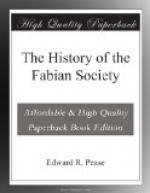“The disaster was so obvious that there was an immediate falling off from the Federation, on the one hand of the sane tacticians of the movement, and on the other of those out-and-out Insurrectionists who repudiated political action altogether, and were only too glad to be able to point to a discreditable instance of it. Two resolutions were passed, one by the Socialist League and the other by the Fabian Society. Here is the Fabian resolution:
“’That the conduct of the Council of the Social-Democratic Federation in accepting money from the Tory party in payment of the election expenses of Socialist candidates is calculated to disgrace the Socialist movement in England,’—4th Dec., 1885.”
The result of this resolution, passed by 15 votes to 4, was the first of the very few splits which are recorded in the history of the Society. Frederick Keddell, the first honorary secretary, resigned and I took his place, whilst a few weeks later Sidney Webb was elected to the vacancy on the Executive.
In 1886 Socialism was prominently before the public. Unemployment reached a height which has never since been touched. Messrs. Hyndman, Champion, Burns, and Williams were actually tried for sedition, but happily acquitted; and public opinion was justified in regarding Socialism rather as destructive and disorderly than as constructive, and, as is now often said, even too favourable to repressive legislation. In these commotions the Society as a whole took no part, and its public activities were limited to a meeting at South Place Chapel, on December 18th, 1885, addressed by Mrs. Besant.
In March, 1886, the Executive Committee was increased to seven by the addition of Mrs. Besant and Frank Podmore, and in April Tract No. 4, “What Socialism Is,” was approved for publication. It begins with a historical preface, touching on the Wars of the Roses, Tudor confiscation of land, the enclosure of commons, the Industrial Revolution, and so on. Surplus value and the tendency of wages to a minimum are mentioned, and the valuable work of Trade Unionism—sometimes




